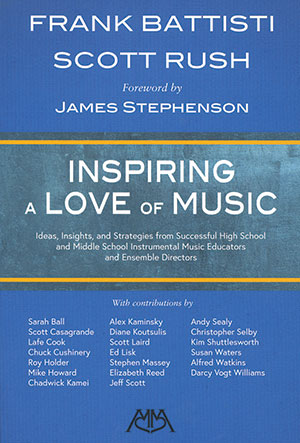Editor’s Note: The following article is based on remarks made by Frank L. Battisti in a session at the Midwest Clinic on December 19, 2022.
Playing music in a band or orchestra is a major component in school music education programs, but the primary objective should be helping students become music lovers. Ideal school music education programs provide students with meaningful music learning and performance experiences – opportunities to create, recreate, and consume music. These experiences can stimulate curiosity, emotions and the intellect. In programs having excessive amounts of large ensemble rehearsal time (during which students realize music composed by someone other than themselves) the time available for students to exercise their imagination and creativity – opportunities to express something that is their own – is limited. This, I believe, is very unfortunate.
We shouldn’t assume that students who play in ensembles that perform at a very high level develop their curiosity, understanding, appreciation and love of music. Their growth might primarily be in performance skills. Rehearsal halls should not be drill sheds where the focus is on playing every rhythm, articulation, and dynamic perfectly. Instead, they should be environments in which students are inspired to play as well as possible while gaining knowledge and awareness of the transforming power of music. This will foster music-making that is meaningful for students, and performances that are well informed and expressive.
Using teaching and rehearsal strategies that include as many aspects of creativity and music-making as possible provide students with opportunities to develop their imagination and love of music as well as expand their emotional connections with others. What is a real love of music? It is not superficial. It is deep and transforming. Like any great love, it is based on an understanding and appreciation of all its elements, how they function, illuminate, and magnify all aspects of human life.
The focal point in all music classrooms and rehearsal halls should be the music. Everyone (including the conductor) should always be listening and watching:
What do I hear?
Who should I listen to?
What do I see?
Who should I watch?
Who has the melody?
What is the form?
How should this melody be phrased?
It’s important that students understand that every sound they make, every note they play should be motivated by a desire to express a thought, an idea, a feeling. Performances should illuminate what the players and conductor collaboratively decide is the expressive message embodied in a work’s notation. Expressive and insightful music-making elicits feelings that touch and wound the heart, stimulate the mind, and develop understanding, appreciation and love of music. It could breed an army of music lovers.
A priority of every course in the school curriculum (especially music courses) should be development of a student’s imagination and creative potential. Composing and improvising music are excellent creative activities that allow students to develop their imagination and create something that is original and completely theirs. These entities should be employed at all levels of music teaching. Music that is created from the inside out is more personal and intimate.
Teaching music as an art through music-making experiences that stimulate questions and emotions, expand student imagination as well as their awareness that much in life is invisible. As Harold Taylor put it, “[This does not take students] out of the material world or out of the context [of their] society, but [is] an experience which moves [them] through contemporary reality into newer levels of awareness of what human society [can be].” Music can transport individuals to places both known and imagined. In recreating, creating, and consuming music, one can experience things that go beyond those normally associated with and encountered in everyday life. One’s physical and intellectual worlds are enlarged and expanded.
Playing music is fun, but remains only fun, unless the quality of the music studied and performed is of high artistic merit. What students study, perform, and consume truly matters. Exposure, consumption, and performance of excellent quality music in diverse styles will stimulate higher musical taste, values and appreciation than those acquired through the consumption of junk food quality music. It is essential that students play music that offers opportunities to be artistically connected with each other. The most thrilling performances (and experiences) are those in which everyone – conductor/teacher and players – commingle in the performance of a piece.
Teachers who are passionate about music keep exploring and consuming great music and great art. Directors attending the Midwest Clinic go to concerts and check out newly published pieces in hopes of discovering something they can use with their ensemble. Enlightened directors also journey down Michigan Avenue to listen to a concert by the Chicago Symphony Orchestra or visit the Art Institute of Chicago to nourish their artistic soul and reap the life-enriching benefits derived from contact with great art. Continuous contact with a broad spectrum of masterpieces from the entire body of great music and art is essential for the ongoing growth and development of the artist school ensemble director.
We teach the most important and valuable subject in the school’s curriculum. Let us strive to create musical experiences that affect young people in ways that lead to both a personal need for and love of music. If we do this, we will contribute greatly to the enrichment of the human experience in the lives of our students.
A newly published book, Inspiring a Love of Music by Frank Battisti and Scott Rush (Meredith/GIA Publications, 2022) provides information, ideas, insights and strategies used by successful high and middle school instrumental music educators and ensemble directors to stimulate an understanding and appreciation of music.







